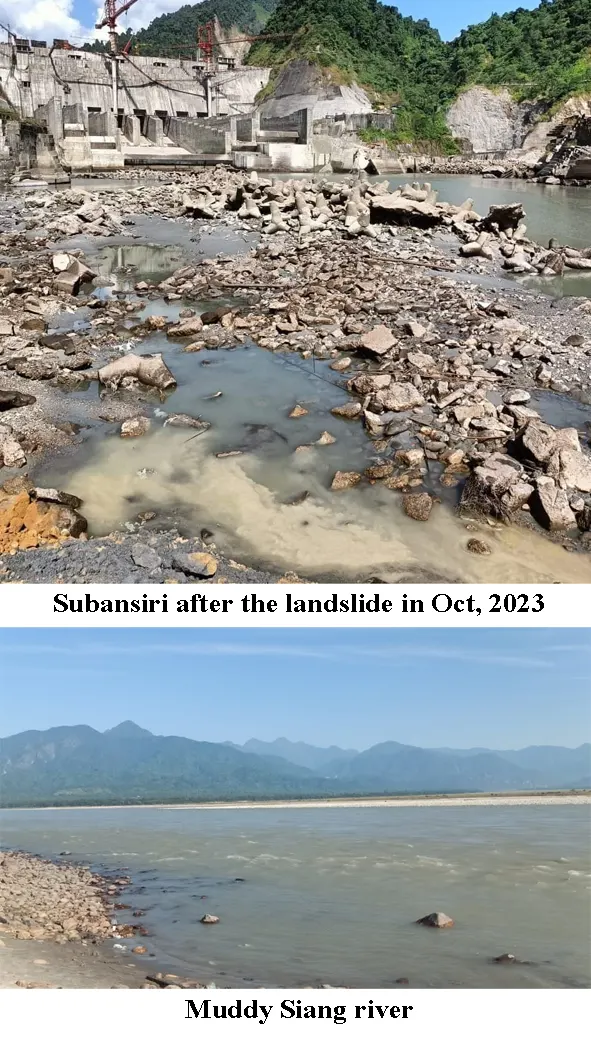 Monday Musing
Monday Musing
[ Tongam Rina ]
In September 2017, the NITI Aayog CEO, after famously taking a chopper ride, announced a 10,000 MW hydropower project in the Siang river. Before he reached Delhi, protests had already erupted in the Siang valley, a region steadfastly opposed to mega hydropower projects. The proposal aimed to build a single multipurpose river valley project for the Siang river, featuring a 300-metre-high dam and a power generation capacity of 10,000 MW to “moderate floods and erosion, providing relief in downstream river reaches of Arunachal and Assam.”
After several organisations shut down the proposal, it’s now in cold storage. However, that didn’t deter the state government from restarting the hydropower mission in Arunachal, starting with the termination of several projects awarded to private players, including the Jindals and Reliance. While terminating 44 memorandums of agreement with an installed capacity of 32,415 megawatts with various private power developers, the government cited that private players had shown “less interest” in executing the allotted projects.
Later, the government roped in central public sector entities like the National Hydroelectric Power Corporation (NHPC), the Satluj Jal Vidyut Nigam, the Tehri Hydro Development Corporation, and the North Eastern Electric Power Corporation Limited (NEEPCO).
There is no stopping now as the state is racing to control the rivers. On many occasions, mandatory compliance has been ignored, and in some cases there’s a direct disregard for indigenous communities.
After years of protests between 2008 and 2013, the construction of the Dibang Multipurpose Project has started.
In the latest update, the NHPC announced that the first blast for excavation of the main access Tunnel-1 of the powerhouse of the 2,880 MW NHPC Dibang Multipurpose Project (DMP) was successfully carried out on 7 December.
For years, the Idu-Mishmis have opposed the project with unwavering determination. They will have none of the state or the Centre’s allurements. It’s well-documented how some members of the community endured threats, were called Maoists, and put under surveillance. The confrontation peaked when students were shot at and injured while celebrating a festival in 2011. A few years later, the protest slowly dwindled. In 2019, the Cabinet Committee on Economic Affairs approved an amount of Rs 1,600 crore for pre-investment activities and various clearances, setting in motion the construction of the largest hydroelectric project ever to be constructed in India with a concrete gravity dam of 278 metres, at estimated total cost of the project at Rs 28,080.35, including IDC & FC of Rs 3,974.95 crore, at the June 2018 price level.
The PIB announced that “the approval of anticipated expenditure on pre-investment activities and various clearances shall enable payment towards compensation for land acquisition and R&R activities (Rs 500.40 crore) to project-affected families and the state government, payment of net present value of forests, compensatory afforestation, catchment area treatment plan to the state government for forest lands, to secure the forest clearance (Stage-2), and construction of roads and bridges for accessing the project site.
In addition to the mandated R&R plan, it is also proposed to spend Rs 241 crore on a community and social development plan and address certain concerns raised by the local people during public hearings. It is also proposed to spend an amount of Rs 327 lakhs on a plan for the protection of the culture and identity of the people.”
The above statement needs scrutiny as the NHPC and the state have not been too prompt with compliance. The Forest Advisory Committee (FAC) of the ministry of environment, forests & climate change (MoEFCC) in 2022 reminded the government of Arunachal Pradesh to submit a report regarding the establishment of a community reserve or conservation reserve near the DMP.
The FAC had earlier suggested establishing a national park, but later suggested establishing a community reserve or conservation reserve under the Wildlife Protection Act, 1972, in consultation with the local people, to safeguard the rights of the indigenous community. The community had rejected the national park.
In 2014, the FAC had said that the “state forest department should initiate the process to declare the right bank of the reservoir up to the ridgeline bordering the basin boundary between the Siang and the Dibang, up to the Dri river to the north as a national park for future preservation of ecological diversity in the river basin.” The state government shared its inability to provide land for a national park, following which the FAC suggested establishing a community reserve. There is no update yet on whether the state forest department has actually started the process of community consultation for a community reserve or a conservation reserve.
Not only this, for a long time, there was a tussle regarding the payment of compensation to the project-affected families as the NHPC was reluctant to pay the compensation, stating that unclassified forest land does not belong to any individual. The NHPC audaciously stated that the indigenous people living in the surrounding areas of the acquired land have only traditional/customary rights over the USF land, which they enjoy collectively on a community basis. The total amount for compensation of the acquisition was Rs 1601,39,31,725. The same CPSU that proposed to spend lakhs for the protection of the culture and identity of the local people refused to acknowledge the land rights of the local people.
Though there has been no classification of the land ownership pattern in Arunachal, unclassified state forests, which make up more than 60 per cent of the total forest cover, are community-owned lands of the indigenous communities. Such controversies will happen in other parts of the state too as the definition of who owns the land vastly differs in the understanding of the state and indigenous communities.
That aside, the project proponents are notorious in the state for noncompliance with safety measures as their attitude seems to be that they will complete the project by any means, even if it means disregarding safety. Such an attitude has resulted in disasters like the recent one in the already disaster-prone NHPC’s 2,000 Subansiri Lower Hydroelectric Project.
The Central Electric Authority had urged the NHPC to enhance construction safety measures after repeated landslides and faulty construction over the years. The latest landslide in October 2023 drastically reduced the Subansiri river’s downstream flow.
Reminder that an earlier study by the MoEFCC had deemed the project site safe. As reported earlier, notwithstanding landslides, flooding, faulty construction, and reduced water level, the NHPC plans to operationalise 250 MW of the plant by January 2024.
Reduced water level has not been limited to Subansiri alone. In December 2022, the NEEPCO’s 600 MW Kameng Hydroelectric Project in the Bichom river reduced the once mighty river to a stream. Fishes have disappeared, causing acute water shortage for downstream villagers, leading to dwindling horticulture and agriculture.
In February 2019, the Panyor (Ranganadi) river turned turbid due to mismanagement by the NEEPC Limited, releasing silt from the 405-MW Ranganadi hydroelectric plant. This led to extreme turbidity downstream, particularly in the Kimin area, destroying aquatic life as fishes turned up dead on the riverbanks.
Rivers turning turbid is not new. The Kameng has. The Siang has turned turbid many times over the years and for prolonged periods. All these are minor inconveniences as all the major rivers have been sold, though construction may not immediately resume, especially in Tawang and the Siang basin, which have consistently opposed mega dams.
On 16 July, 2015, the legislative assembly was informed that Arunachal had received Rs 1,495.6 crore as upfront money and processing fees in the last 10 years from various power developers. A chunk of this – Rs 1,277 crore – was received between 2007 and 2011.
Between 2007 and 2015, the Arunachal government signed agreements for 142 hydropower projects, ranging in capacity from 4.50 MW to 4,000 MW, without feasibility studies. One of the recipients of the projects was a travel company.
Given the disastrous outcomes of hydropower projects in the Himalayan regions of the country and neighbouring Bhutan, proceeding with numerous hydropower projects in an ecologically fragile state like Arunachal doesn’t seem feasible. In Sikkim, 30 people lost their lives recently after a glacial lake outburst flood. Uttarakhand has been twice hit by similar tragedies, while Himachal is devastated by hydropower projects-induced disasters.
If we draw a parallel, the highways being built across the state serve as a stark reminder that manipulating mountains and hills not only costs human lives but also devastates the surrounding environment. Statistics indicate that interfering with natural environments often leads to devastating effects, such as the landslide in Laptap village that claimed 14 lives in July 2017 due to earth-cutting by Sushee Infra.
In Itanagar, 6 Mile along the highway remains highly susceptible to landslides. In July 2020, four people were buried alive. Though no one has been held responsible, TK Engineering cannot deny the impact of faulty engineering on hill roads. Previously, a small waterfall existed; each monsoon, that section of the road turns into a muddy roaring stream. It’s evident that trying to bury a stream will only make it more resilient, as water inevitably finds its way.
Roads have become burial grounds in Bomdila-Tawang, Yupia-Ziro, Likabali-Basar, and recently in Upper Subansiri. These realities underscore the fragility of mountainous states. Rushing to build hydropower projects in the name of national security and financial self-reliance shouldn’t overlook these hazards.
None of the completed or near-completion hydropower projects have been without major disasters. The Ranganadi project continues to wreak havoc in downstream villages in Arunachal and Assam every monsoon. Villages along the river route in Papum Pare are prohibited from venturing into the river after 3 pm as water is released downstream. Many people who defied such orders, knowingly or in ignorance, have lost their lives in the river.
The government must acknowledge these realities and deeply question whether it’s truly worth the cost. Is it truly possible to control rivers without impacting the immediate and downstream areas in Assam and Arunachal? Or is national security, often cited as the reason for hydro projects, prioritised despite the fact that the maximum flow of the rivers is due to glaciers within the Indian territory in Arunachal, at the expense of local communities?
Is financial self-reliance, sought from hydro projects, deemed so crucial that the state is willing to disregard the ecological fragility of an area susceptible to earthquakes and landslides?
While hydroelectric power might be less polluting, as claimed, it’s a flawed statement that disregards indigenous people in the state. It erases the communities themselves, as their lives are intricately linked to the river and land. Clean and green energy should not come at the cost of uprooting communities residing alongside rivers, destroying their land and forests, and erasing their history and memories.
The cost of constructing these hydropower projects is massive and irreparable. The choice is ours to make.


